The short version: the above graphic is the latest incarnation of my marketing technology landscape supergraphic (click for a high-resolution 2600×1950 version, 4.7MB). It represents a whopping 947 different companies that provide software for marketers, organized into 43 categories across 6 major classes.
A high-resolution PDF version is also available (14.3MB). Please feel free to copy, repost, distribute, and use this graphic “as is” in any context you’d like.
It comes with one main caveat: this graphic is not comprehensive. It is just a sample, albeit a large one, of the many different kinds of software available to marketers today. There are many more companies — indeed, entire categories — that were not included, merely due to the constraints of time and space. And by the time you read this, it will inevitably be out of date due to new launches, re-launches, expansions, exits, and mergers. The pace of change in this field is breathtaking.
That’s the short version. For further elaboration, read on.
This is the third version of this landscape that I’ve produced. The first version was in August 2011 and the second was in September 2012. Here’s how they’ve progressed:
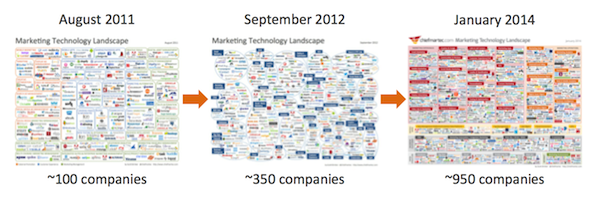
It’s been 16 months since the last version because, frankly, I wasn’t planning to do another. Terry Kawaja of LUMA Partners had added a terrific marketing technology LUMAscape — his original display advertising LUMAscape was my inspiration for my first landscape. The folks at Gartner had released their brilliant digital marketing transit map. I was content to retire from the rearranging-little-logos business and leave it safely in their hands.
But two things brought me out of retirement. First, the number of people who kept using earlier versions of my graphic and expressing their appreciation for it — while also nudging me to, um, kindly update it — meant a lot to me.
Second, I had a breakthrough in how to organize the landscape that got me really excited.
One of the things that I was less than happy about with the previous version was its lack of underlying structure. One commenter wrote, “seems to be a bit of an icon ghetto without a ton of insight.” Harsh, but true. I was expressing the magnitude of the marketing technology space, but I wasn’t bringing much order to the chaos. A new version in that same format with even more icons would just exacerbate the mayhem.
The breakthrough occurred in discussions around my post in October on the emerging third-party era of marketing automation. Marketing automation, CRM, WCM, and e-commerce engines were increasingly serving as true platforms, with ecosystems of interoperable marketing applications growing around them.
An exchange in the comments with David Raab also led me to his insightful thinking about customer data platforms (CDPs). It struck me that these CDPs, along with some other technologies such as tag management and cloud connector services such as Zapier, were coalescing as marketing middleware — software to help all the other software in marketing work better together.
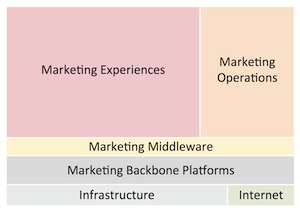
And so six classes of marketing technology seemed to logically fit together into — gasp! — a semblance of meaningful structure:
But before we explore these classes further, let’s talk about categorization for a moment.
There are two inevitable — and legitimate — questions from vendors and their followers:
To start, let’s agree that any attempt at categorizing a field this large will be imperfect. For one thing, there are opposing forces that cause vendors to want to embrace specialized new labels — to own their own category — yet also be recognized in broad existing categories (since that’s where there’s usually a large, identified market). It’s a tension that every product manager in this space wrestles with.
The situation is further complicated by the fact that categories can always be divided into subcategories, the labels and definition of categories vary depending on who you ask, many products cross multiple categories, and vendors are constantly acquiring and pivoting their way into different categories. It’s a bit of a hot mess, and there’s a near infinite number of ways you could divvy it up.
Out of those infinite possibilities, this is merely one: my humble opinion, at this moment in time, about which categories might be most useful to a marketer surveying this landscape.
For the most part, I avoided duplicating companies across categories, with very few exceptions. So if a vendor’s products spanned multiple categories — which many of them do — I usually just picked one, whichever one I thought was best. The main exceptions are the giants who have acquired across the whole space, such as Adobe, IBM, and Oracle.
However, while categories are useful to illustrate clusters of related marketing technologies, many innovative products out there are being designed outside the boundaries of these categories. For the record, I think that’s awesome. Our industry is young, and there’s so much potential for innovation. Inventing the future shouldn’t be constrained by the labels of the past.
All that is to say: take my categorization choices with a grain of salt.
There’s a lot here to discuss. To do it justice, I’ll do a series of in-depth, follow-up articles over the next few months. But here’s the highlight reel of what I found most interesting while working on this:
1. Marketing Backbone Platforms and Marketing Middleware. These two classes of products are bringing some much needed structure to the marketing technology stack.

Platforms are software that every marketer needs — a CRM, a core web content/experience system, and at least basic marketing automation (i.e., campaigns and customer journey management). And an e-commerce engine, if that’s part of your business. You may get these pieces from one vendor or several, but they will serve as the foundation for your marketing technology stack. What makes them platforms, rather than just products, is that they’re increasingly open — interoperable with other, more specialized marketing software.
Middleware is the “software glue” that makes it even easier for multiple, different products to work together. Instead of each product needing to explicitly integrate with each other product out there — an impossible n2 integration points — middleware can serve as a common highway system for data between them. Data management platforms (DMPs) and customer data platforms (CDPs) are the emerging giants in this role, but tag management, cloud automation/integration products, user management/single sign-on services, and API management are all a part of this important connective tissue.
Combined, these platforms and marketing middleware make it increasingly manageable to orchestrate diverse marketing software products into a cohesive stack. Each business will be better able to tailor a marketing technology portfolio that best serves their mission. (Prediction: this will further invigorate innovation in marketing technology point solutions.)
2. The Emergence of the Marketing Apps Category. I believe there’s a new category of marketing software that’s emerging for marketing apps. These products let marketers produce interactive experiences, rather than static content, to engage their audience.
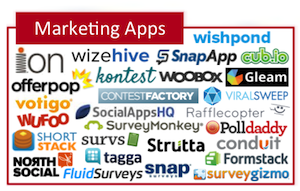
This nascent category contains products that were once considered unrelated to each other — polls and surveys, social contests and sweepstakes, and app-like web and mobile experiences such as wizards, configurators, calculators, etc. But I believe they share a common DNA of letting marketers build interactive experiences to better acquire and nurture customers — without expensive, custom programming.
In full disclosure, the company I co-founded, ion interactive, is included here. I’ve been increasingly impressed with the app-like experiences that our customers are building with our product and the results they’ve been able to achieve with them. I’m not going to pitch you here, I promise, but if you want to see examples of these “marketing apps,” check out the Marketing App Idea Book we published last month.
3. Consolidation and Diversification in Marketing Automation. The second largest category of products in this landscape is marketing automation/integrated marketing platforms, with 51 different vendors. Many of these are new ventures or expansions of vendors from other categories (especially email marketing). And there are undoubtedly more that I inadvertently overlooked (my apologies). It’s a big category.

My point is that although there has been some notable consolidation in the marketing automation space — Adobe (Neolane), IBM (Unica), Marketo, Oracle (Eloqua and Responsys), Salesforce.com (Pardot and ExactTarget), and Teradata (Aprimo) — there has also been significant diversification.
I’ve always considered marketing automation to be a bellwether for the larger marketing technology ecosystem, and I believe this blossoming of new contenders confirms two important facts:
It will be interesting to watch the dynamics of this play out. One prediction is that some of the first generation marketing automation players will likely acquire several of these second generation players — to achieve further reach and hedge their bets on product design choices. (Not unlike the possibilities Salesforce.com faces with ExactTarget and Pardot and Oracle faces with Eloqua and Responsys.)
4. “Ad Tech” in the Minority in the Marketing Technology Landscape. Out of the 947 companies included here, only about 10% are focused on advertising. Granted, this landscape is not comprehensive, and there are many advertising technology companies that are missing from it. But there are also many non-advertising vendors missing too.
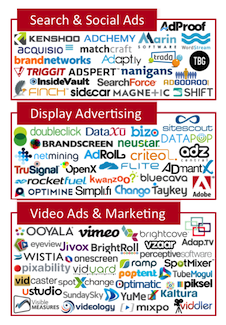
Even if the ratio is off by a factor of 2X or 3X, there’s still no denying that the vast majority of marketing technology innovation is happening outside the context of advertising.
This is indicative of — and directly enabling — the seismic shift of marketing away from advertising to experience-driven marketing. Content marketing, social media marketing, interactive experiences, and the analytical capabilities to optimize those efforts with continuous experimentation are where the largest flood of innovation is occurring. For instance, there are 66 vendors in just the social media marketing category alone (and many more that I couldn’t squeeze in).
The evolution of many demand-side platforms (DSPs) to data management platforms (DMPs) is another sign of the times. DSPs are focused on ads. DMPs are increasingly able to leverage audience data across a much broader range of marketing initiatives. (It’s here where the line between DMPs and CDPs is getting blurry.)
To be sure, there are many amazing advertising technology vendors out there, and new ones will continue to arise. But the momentum of the burgeoning marketing technology field clearly has a different center of gravity.
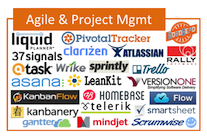
5. A Rich Collection of Agile Marketing Tools. Finally, I’m excited by the wonderful set of agile management tools that are available today. Granted, most of these were not designed specifically with marketing in mind. But the ones I selected here can work beautifully in supporting agile marketing.
More generally, the growth and innovation with these products speaks to the increasing traction that agile and lean management philosophies are gaining across more and more organizations.
Because while all the incredible marketing technologies illustrated in this landscape are dramatically changing what’s technically possible for businesses to achieve, the bottlenecks that still hold teams back are more likely to be the remnants of management approaches from the last century.
The continued rise of agile methods and culture, however, is helping to reinvent marketing management for this century — so the human parts of our marketing, which will always be the most important parts, can harness the full potential that all this technology has to offer us.
Those are my initial thoughts. As you explore this landscape, I’d love to hear yours.
P.S. If I missed including your company in this landscape, I apologize. No slight was intended. Please feel free to tell us about your venture in the comments below. No guarantees, but when I go to do another version of this landscape in the future, I’ll check here first.
By: Scott Brinker, Co-founder & CTO at ion interactive, inc.
Originally published at chiefmartec.com